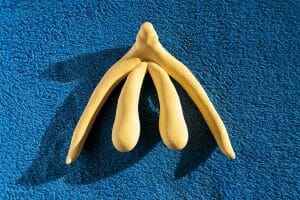Vaginal vs. Clitoral Orgasms: Are They Really So Different? Dr. Jess Weighs In

First of all, what is an orgasm?
For many, an orgasm is the ultimate sexual indulgence that leaves you feeling relaxed, fulfilled, and at ease in your mind and body.
The French refer to the orgasm as la petite mort (the little death). Dr. Ruth Wertheimer describes it as a sneeze. And dictionaries define it as the peak of sexual excitement followed by a palpable sense of release. Some of the women I work with describe orgasms as little sighs, earth-shattering movements, and total body eruptions.
Each of these descriptions provides evidence that no universal definition of a women’s orgasm exists.
What we do know is that there are multiple pathways to female orgasm, which suggests that there are, in fact, different types.
It’s important to note, however, that orgasms do not fit neatly into categories based on a particular body part, as the body is complex. Its many parts are connected by an arrangement of nerves and muscles. Orgasms, therefore, can occur from an infinite number of techniques and approaches.
We may experience different types of orgasms (and the way we classify them is highly subjective), but we cannot perfectly categorize them into a checklist system.
The clitoris isn’t just near the vagina — the internal clitoris also surrounds the vagina.

When we compare clitoral orgasms to vaginal orgasms, we have to consider the fact that the clitoral complex is not only located in close proximity to the vaginal canal, but parts of the clitoris actually surround the vagina. That makes it difficult to isolate the exact source of sexual stimulation and orgasm.
Moreover, I want to emphasize that there is no pleasure hierarchy.
You don’t get extra points for having a vaginal orgasm, and you won’t necessarily have better orgasms because you learn to squirt.
Your experiences of sexual satisfaction, pleasure, and orgasm are all that matter. You’re the expert, so go ahead and experiment with different types of orgasms, but don’t get hung up on checking multiple types off of a list. Instead, enjoy the process and let your own pleasure be your guide.
What Are Clitoral Orgasms?
The clitoris serves only one function: pleasure.
Because the clitoris is a significant source of orgasmic pleasure, its stimulation tends to be the most reliable path to orgasm for many. You may recall from 8 Things You May Not Know About the Clitoris that the clitoris is comprised of many parts — both internal and external. Because the clitoral complex is so large and shares many connections with the entire pelvic region, you can experience clitoral stimulating and orgasm from a wide array of techniques.
How to Have a Clitoral Orgasm
You can stroke the clitoral legs and bulbs through the labia, rub its shaft via the hood, excite its erectile tissue through the shallow walls of the vagina or apply direct pressure to its highly sensitive head.
You may like direct vibes on the outside or gentle rumbly sensations via the vaginal canal, or you might find that simply cupping your hand around your entire vulva allows you to grind against the full clitoris — inside and out.
As always, the best way to figure out what works is to play with yourself and share your findings with your lover. Your body is constantly changing, so what works today may not work tomorrow. Our continuous sexual evolution highlights the need for ongoing experimentation and serves the purpose of keeping sex fresh and exciting.
6 Clitoral Orgasm Techniques to Try Tonight
- During intercourse, grind against any firm surface you can find: a mattress, the edge of your bed, your fingertips, your partner’s pelvic bone, thigh, or a toy for clitoral stimulation.
- Squeeze your legs together and roll a toy or your fingers against the head and hood of your clitoris as you grind.
- Wrap your legs around a rolled-up bed sheet and grind it against your labia. Recall the sensation of climbing the hanging ropes in gym class for inspiration. If you have a pole in your house (and who doesn’t these days?), try squeezing your legs tightly around it as you lower yourself up and down with your feet on the floor.
- Rub your vulva over any firm surface allowing your body weight to create extra friction. The arm of a padded couch or a rounded staircase banister should do the trick.
- Slide a flat or wide vibrator like the We-Vibe Wish or the Hitachi Magic Wand back and forth over the entire vulva in the motion of a swinging grandfather clock pendulum.
- Slide your favorite toy inside and encircle it around the shallow opening of your vagina to stimulate the erectile tissue of the clitoris on the inside.

What Are Vaginal Orgasms?
Research suggests that vaginal penetration alone results in orgasm for approximately one-third of women, but this does not mean that all vaginal orgasms are distinct from clitoral ones.
The vagina and clitoris are not only neighbors, but they’re connected by a number of nerve pathways and muscular structures. The corpora cavernosa of the clitoris, two sponge-like tubes that form the erectile tissue of its body are positioned around the vaginal canal.
For this reason, some experts believe that all genital orgasms are clitoral in nature on account of the corollary stimulation through the vagina. Others disagree. They sometimes point to laboratory observations of brain activity during orgasm that shows different areas activating depending on which part of the genitals are being stimulated.
To quote The Female G-Spot: Your Ultimate Guide:
Women often report that a G-Spot orgasm feels different from a clitoral one, as they experience sensations of bearing down with their pelvic floor muscles as opposed to the tenting effect from clitoral stimulation.
Dr. Beverly Whipple and Dr. Barry Komisaruk have also discovered that vaginal, cervical and G-Spot stimulation activates different parts of the brain via four different nerve pathways that innervate the clitoris, vagina and cervix.
But even these researchers acknowledge that there is some overlap between clitoral and vaginal orgasms, suggesting that perhaps it doesn’t matter how we label our orgasms — only that we indulge in them.
How to Have a Vaginal Orgasm
If you’re interested in exploring vaginal orgasms, consider these 4 approaches:
- Swirl the well-lubricated object of your choice (a tongue, penis, toy or finger) around the opening of your vagina in a circular motion against its walls. Gradually increase the depth as you work your way to the very back, pressing into the sides as they swell with pleasure.
- Whether a toy or penis, alternate between shallow, slow, gentle thrusts and deep, hard pumping, as the outer part of the canal tends to be sensitive to light touch whereas the deeper zone is often more reactive to pressure.
- Squeeze and release your pelvic floor muscles every half-second during penetration to increase blood flow and mimic the contractions of orgasmic response.
- Combine vaginal stimulation with pressing a small vibrator or finger against the head of the clitoris on the outside.
However, you play, rest assured that you’re perfectly normal. There is an infinite number of pathways to orgasm from kinky humiliation to romantic cuddling, and only you decide what works for you.

More Great Female Orgasm Tips
Many women and people with vulvas struggle with achieving orgasm, which is nothing to be ashamed of! If you’re looking to improve your odds of the big O, read this article on how to achieve orgasm faster.
Maybe you’ve heard about women having multiple orgasms, and want to try it for yourself. Try these 7 tricks for multiple orgasms.
If you’re reading this because you want to help your partner have more or better orgasms, read my article on what women want in bed, according to science.
For more on the science of orgasm, here’s a fascinating look at female orgasm and fertility.
Clitoral vs. Vaginal Orgasms: Which Is Your Favorite?
Do you believe, like some researchers, that all orgasms are clitoral orgasms? Or do you think vaginal orgasms are a separate kind of delicious pleasure? Let us know by tweeting us @ASTROGLIDE!
Dr. Jess O’Reilly, Ph.D. is a Toronto-based sexologist specializing in sexuality counseling, clinical sexology, sex education, and healthy relationships. Learn more about Dr. Jess here.
